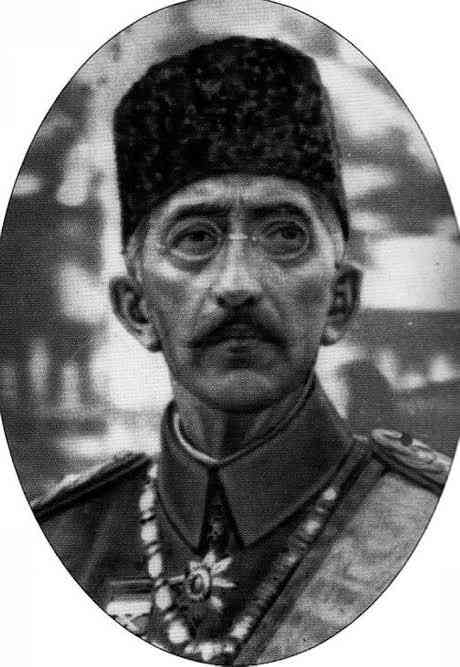Osmanlı İmparatorluğu’nun son padişahı olan Mehmed Vahdettin (VI. Mehmed), 1918-1922 yılları arasında tahtta bulunmuştur. Birinci Dünya Savaşı sonrasında Osmanlı Devleti’nin dağılma sürecine girdiği en zor dönemlerden birine liderlik eden Mehmed Vahdettin, tarih sahnesindeki son Osmanlı hükümdarı olarak tanınır. Hem iç hem de dış politikada yaşanan sıkıntılar, onun liderlik dönemini belirlemiştir. Şimdi, Mehmed Vahdettin’in hayatını ve Osmanlı tarihindeki yerini detaylı bir şekilde inceleyelim.
Mehmed Vahdettin, also known as VI. Mehmed, was the 36th and last Sultan of the Ottoman Empire, ruling from 1918 to 1922. Born on February 2, 1861, in Istanbul, he ascended to the throne during one of the most turbulent periods in Ottoman history. Following the collapse of the Ottoman Empire after World War I, Mehmed Vahdettin faced immense challenges, including foreign occupation, nationalist uprisings, and the eventual abolition of the sultanate. His reign remains a subject of historical debate, symbolizing the end of an era and the beginning of a new chapter in Turkish history.
Early Life and Background
Birth and Lineage
Mehmed Vahdettin was born into the Ottoman royal family at a time when the empire was grappling with internal and external challenges. His father, Sultan Abdülmecid I, was known for his reformist policies, while his mother, Gülistu Kadın, provided a strong maternal influence. Growing up in the Dolmabahçe Palace, he witnessed the empire's gradual decline, shaping his outlook on leadership.
Education and Upbringing
Vahdettin received a traditional Ottoman education, which included Islamic studies, governance, and foreign languages. He was particularly influenced by the political and military crises of the late 19th century, which underscored the need for strong leadership and reform.
Role as a Prince
Before ascending the throne, Vahdettin served in various ceremonial and administrative roles within the Ottoman court. His time as a prince allowed him to observe the complexities of governance and the challenges facing the empire.
Personal Traits and Interests
Known for his introspective and cautious nature, Mehmed Vahdettin was deeply religious and committed to preserving the Ottoman dynasty. He also had a keen interest in literature and music, reflecting the cultural richness of the late Ottoman court.
Path to the Throne
In 1918, following the death of Sultan Mehmed V Reşad and the short reign of Sultan Mehmed VI, Mehmed Vahdettin ascended the throne during a period of immense turmoil for the empire.
The Reign of VI. Mehmed
Post-World War I Challenges
Mehmed Vahdettin became Sultan during the aftermath of World War I, which left the Ottoman Empire defeated and occupied by Allied forces. The signing of the Armistice of Mudros in 1918 marked the beginning of foreign occupation in key Ottoman territories, including Istanbul.
Relations with the Allied Powers
As Sultan, Vahdettin attempted to navigate the complex political landscape by cooperating with the Allied powers, hoping to preserve the Ottoman state. However, this strategy was met with criticism from nationalist factions within the empire.
Rise of Turkish Nationalism
The emergence of the Turkish National Movement, led by Mustafa Kemal Atatürk, posed a significant challenge to Mehmed Vahdettin's authority. The movement sought to establish a modern, independent Turkish state, free from foreign occupation and Ottoman rule.
The Treaty of Sèvres
In 1920, the signing of the Treaty of Sèvres further weakened the Ottoman Empire, as it ceded vast territories to Allied powers and restricted Ottoman sovereignty. This treaty intensified nationalist opposition and further marginalized the Sultan’s authority.
Conflict with Mustafa Kemal Atatürk
Mehmed Vahdettin's relationship with Mustafa Kemal Atatürk was marked by tension and conflict. While Vahdettin viewed Atatürk as a threat to the Ottoman dynasty, Atatürk regarded the Sultan as a symbol of submission to foreign powers.
The Abolition of the Sultanate
Growing Opposition
By 1922, the nationalist movement had gained significant momentum, culminating in the establishment of the Grand National Assembly in Ankara. This new government effectively sidelined the Sultan and marked the beginning of the end for the Ottoman sultanate.
Exile of VI. Mehmed
On November 1, 1922, the Grand National Assembly officially abolished the sultanate. Mehmed Vahdettin was deposed and fled Istanbul aboard a British warship, seeking refuge in Malta before eventually settling in Italy.
Life in Exile
In exile, Vahdettin lived a modest life, reflecting on the events that led to the fall of the Ottoman Empire. He passed away in Sanremo, Italy, on May 16, 1926, far from the empire he once ruled.
Impact on Ottoman Legacy
The abolition of the sultanate marked the end of a six-century-long dynasty. While Vahdettin’s reign is often criticized, it also symbolizes the challenges of leading an empire in its final days.
Historical Perspectives
Historians remain divided on Mehmed Vahdettin's legacy. Some view him as a tragic figure who faced insurmountable challenges, while others criticize his decisions during the empire’s decline.
Legacy and Historical Significance
Cultural Contributions
Despite the turmoil of his reign, Mehmed Vahdettin supported cultural and educational initiatives, emphasizing the importance of preserving Ottoman traditions.
Role in Modern Turkish History
Vahdettin’s reign represents a transitional period between the Ottoman Empire and the modern Republic of Turkey. His actions and decisions continue to be studied and debated.
A Symbol of an Era
As the last Ottoman Sultan, Mehmed Vahdettin embodies the complexities of the late Ottoman period, marked by both grandeur and decline.
Lessons from His Leadership
Vahdettin’s reign highlights the difficulties of leadership during times of crisis and the importance of adaptability in governance.
End of the Ottoman Era
His departure from Istanbul symbolized the final chapter of the Ottoman Empire, paving the way for the establishment of the Republic of Turkey in 1923.
Mehmed Vahdettin (vı. Mehmed) İngilizce Biyografisi
"Mehmed Vahdettin (VI. Mehmed) İngilizce Biyografisi" başlığı altında, Osmanlı İmparatorluğu’nun son padişahı olan Mehmed Vahdettin’in liderliği ve dönemi detaylı şekilde ele alındı. Onun dönemi, Osmanlı’nın çöküşü ile modern Türkiye’nin doğuşu arasındaki dönüm noktasıdır.
Summary: The Last Sultan of a Declining Empire
- Mehmed Vahdettin (VI. Mehmed) was the last Sultan of the Ottoman Empire, reigning from 1918 to 1922.
- He ascended the throne during a period of immense turmoil following World War I.
- His reign faced challenges such as foreign occupation, nationalist uprisings, and political instability.
- The Treaty of Sèvres and the rise of Mustafa Kemal Atatürk further weakened his authority.
- In 1922, the abolition of the sultanate marked the end of Ottoman rule.
- Exiled in Italy, Vahdettin lived a modest life until his death in 1926.
- His reign is both criticized and sympathized with, representing the complexities of the late Ottoman period.
- Vahdettin’s legacy remains a symbol of the transition from empire to republic.



